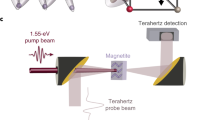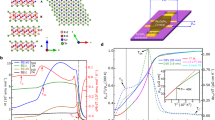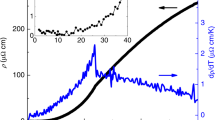Abstract
Magnetite (Fe3O4), an archetypal transition-metal oxide, has been used for thousands of years, from lodestones in primitive compasses1 to a candidate material for magnetoelectronic devices2. In 1939, Verwey3 found that bulk magnetite undergoes a transition at TV≈120 K from a high-temperature ‘bad metal’ conducting phase to a low-temperature insulating phase. He suggested4 that high-temperature conduction is through the fluctuating and correlated valences of the octahedral iron atoms, and that the transition is the onset of charge ordering on cooling. The Verwey transition mechanism and the question of charge ordering remain highly controversial5,6,7,8,9,10,11. Here, we show that magnetite nanocrystals and single-crystal thin films exhibit an electrically driven phase transition below the Verwey temperature. The signature of this transition is the onset of sharp conductance switching in high electric fields, hysteretic in voltage. We demonstrate that this transition is not due to local heating, but instead is due to the breakdown of the correlated insulating state when driven out of equilibrium by electrical bias. We anticipate that further studies of this newly observed transition and its low-temperature conducting phase will shed light on how charge ordering and vibrational degrees of freedom determine the ground state of this important compound.
This is a preview of subscription content, access via your institution
Access options
Subscribe to this journal
Receive 12 print issues and online access
$259.00 per year
only $21.58 per issue
Buy this article
- Purchase on Springer Link
- Instant access to full article PDF
Prices may be subject to local taxes which are calculated during checkout




Similar content being viewed by others
References
Mills, A. A. The lodestone: History, physics, and formation. Ann. Sci. 61, 273–319 (2004).
Coey, J. M. D. & Chien, C. L. Half-metallic ferromagnetic oxides. Mater. Res. Soc. Bull. 28, 720–724 (2003).
Verwey, E. J. W. Electronic conduction in magnetite (Fe3O4) and its transition point at low temperatures. Nature 144, 327–328 (1939).
Verwey, E. J. W. & Haayman, P. W. Electronic conductivity and transition point of magnetite. Physica 8, 979–987 (1941).
Walz, F. The Verwey transition—a topical review. J. Phys. Condens. Matter 14, R285–R340 (2002).
Garciá, J. & Subías, G. The Verwey transition—a new perspective. J. Phys. Condens. Matter 16, R145–R178 (2004).
Huang, D. L. et al. Charge-orbital ordering and Verwey transition in magnetite measured by resonant soft x-ray scattering. Phys. Rev. Lett. 96, 096401 (2006).
Nazarenko, E. et al. Resonant x-ray diffraction studies on the charge ordering in magnetite. Phys. Rev. Lett. 97, 056403 (2007).
Subías, G. et al. Magnetite, a model system for mixed-valence oxides, does not show charge ordering. Phys. Rev. Lett. 93, 156408 (2004).
Rozenberg, G. K. et al. Origin of the Verwey transition in magnetite. Phys. Rev. Lett. 96, 045705 (2006).
Piekarz, P., Parlinksi, K. & Oleś, A. M. Mechanism of the Verwey transition in magnetite. Phys. Rev. Lett. 97, 156402 (2006).
Gasparov, L. V. et al. Infrared and Raman studies of the Verwey transition in magnetite. Phys. Rev. B 62, 7939–7944 (2000).
Imada, M., Fujimori, A. & Tokura, Y. Metal–insulator transitions. Rev. Mod. Phys. 70, 1039–1263 (1998).
Coey, M. Condensed-matter physics: Charge-ordering in oxides. Nature 430, 155–157 (2004).
Leonov, I., Yaresko, A. N., Antonov, V. N. & Anisimov, V. I. Electronic structure of charge-ordered Fe3O4 from calculated optical, magneto-optical Kerr effect, and O K-edge x-ray absorption spectra. Phys. Rev. B 74, 165117 (2006).
Pinto, H. P. & Elliot, S. D. Mechanism of the Verwey transition in magnetite: Jahn–Teller distortion and charge ordering patterns. J. Phys. Condens. Matter 18, 10427–10436 (2006).
Asamitsu, A., Tomioka, Y., Kuwahara, H. & Tokura, Y. Current switching of resistive states in magnetoresistive manganites. Nature 388, 50–52 (1997).
Sawa, A., Fujii, T., Kawasaki, M. & Tokura, Y. Hysteretic current–voltage characteristics and resistance switching at a rectifying Ti/Pr0.7Ca0.3MnO3 interface. Appl. Phys. Lett. 85, 4073–4075 (2004).
Yu, W. W., Falkner, J. C., Yavuz, C. T. & Colvin, V. L. Synthesis of monodisperse iron oxide nanocrystals by thermal decomposition of iron carboxylate salts. Chem. Commun. 2004, 2306–2307 (2004).
Zhou, Y., Jin, X. & Shvets, I. V. Enhancement of the magnetization saturation in magnetite (100) epitaxial films by thermo-chemical treatment. J. Appl. Phys. 95, 7357–7359 (2004).
Pérez-Diete, V. et al. Thermal decomposition of surfactant coatings on Co and Ni nanocrystals. Appl. Phys. Lett. 83, 5053–5055 (2003).
Zeng, H. et al. Magnetotransport of magnetite nanoparticle arrays. Phys. Rev. B 73, 020402(R) (2006).
Shvets, I. V. et al. Long-range charge order on the Fe3O4(001) surface. Phys. Rev. B 70, 155406 (2004).
Burch, T. et al. Switching in magnetite: A thermally driven magnetic phase transition. Phys. Rev. Lett. 23, 1444–1447 (1969).
Freud, P. J. & Hed, A. Z. Dynamics of the electric-field-induced conductivity transition in magnetite. Phys. Rev. Lett. 23, 1440–1443 (1969).
Duchene, J., Terraillon, M., Pailly, P. & Adam, G. Filamentary conduction in VO2 coplanar thin-film devices. Appl. Phys. Lett. 19, 115–117 (1971).
Gu, Q., Falk, A., Wu, J., Ouyang, L. & Park, H. Current-driven phase oscillation and domain-wall propagation in WxV1−xO2 nanobeams. Nano Lett. 7, 363–366 (2007).
Salazar, A., Oleaga, A., Wiechec, A., Tarnawski, Z. & Kozlowski, A. Thermal diffusivity of Fe3−xZnxO4 . IEEE Trans. Magn. 40, 2820–2822 (2007).
Acknowledgements
This work was supported by the US Department of Energy grant DE-FG02-06ER46337. D.N. also acknowledges the David and Lucille Packard Foundation and the Research Corporation. V.L.C. acknowledges the NSF Center for Biological and Environmental Nanotechnology (EEC-0647452), Office of Naval Research (N00014-04-1-0003) and the US Environmental Protection Agency Star Program (RD-83253601-0). C.T.Y. acknowledges a Robert A. Welch Foundation (C-1349) graduate fellowship. R.G.S.S. and I.V.S. acknowledge the Science Foundation Ireland grant 06/IN.1/I91.
Author information
Authors and Affiliations
Contributions
S.L. fabricated and measured the devices in this work and analysed the data. A.F. fabricated devices and carried out X-ray diffraction characterization of the nanocrystal materials. D.N. and S.L. wrote the paper. J.T.M. and C.Y.Z. made the nanocrystals in V.L.C.’s laboratory and V.L.C. contributed expertise in nanomaterials chemistry and characterization. R.G.S.S. and I.V.S. grew the magnetite films and I.V.S. contributed expertise on magnetite physical properties. All authors discussed the results and commented on the manuscript.
Corresponding author
Supplementary information
Supplementary Information
Supplementary information, figures S1-S6 and supplementary references/notes (PDF 465 kb)
Rights and permissions
About this article
Cite this article
Lee, S., Fursina, A., Mayo, J. et al. Electrically driven phase transition in magnetite nanostructures. Nature Mater 7, 130–133 (2008). https://doi.org/10.1038/nmat2084
Received:
Accepted:
Published:
Issue Date:
DOI: https://doi.org/10.1038/nmat2084
This article is cited by
-
PrMnCo-Ti3C2 MXene nanocomposite-based supercapacitor for the optimization of electrochemical performance
Journal of Materials Science: Materials in Electronics (2024)
-
Giant linear magnetoresistance in half-metallic Sr2CrMoO6 thin films
npj Quantum Materials (2021)
-
Ultrafast reprogrammable multifunctional vanadium-dioxide-assisted metasurface for dynamic THz wavefront engineering
Scientific Reports (2020)
-
Pressure tuning of charge ordering in iron oxide
Nature Communications (2018)
-
Spin-dependent transport properties of Fe3O4/MoS2/Fe3O4 junctions
Scientific Reports (2015)



